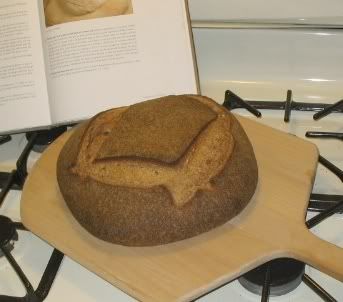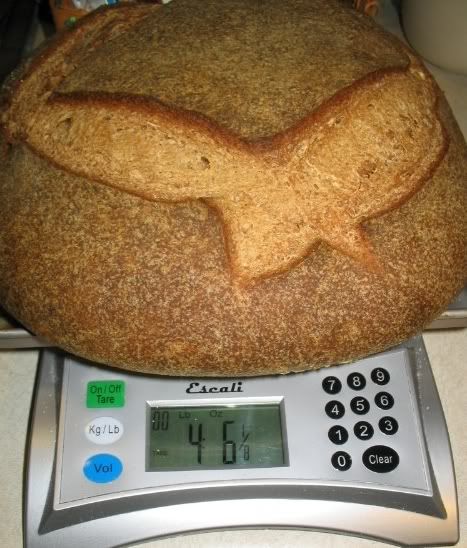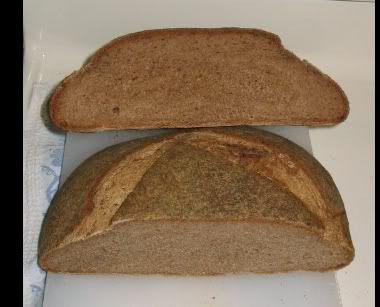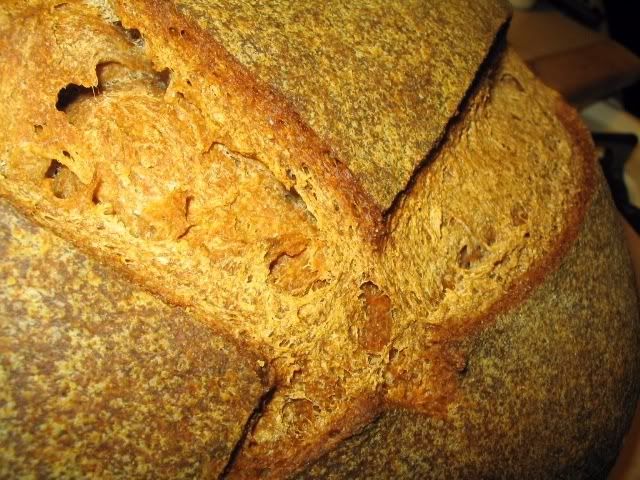I have to start off by saying that this was a very rewarding learning experience and I hope to be able to articulate some of what I learned by making this miche.
So I had a weak moment on Amazon a few weeks back and ordered Reinhart's BBA and Whole Grains books as I've been wanting them for two Christmas' and a birthday but my wife and family never seemed to get the blatant hints. I read BBA first as here at The Fresh Loaf it is considered gospel. I found it to be a well put together, well thought out, easy to read book. Peter Reinhart's teaching style comes through very well and he made concepts like bakers percentages make sense to me after I'd read and had time to digest them.
Day 1: I started out three days ago by making a hardball pre-ferment with KA Whole Wheat flour sifted through a fine mesh strainer, sourdough starter, and a little filtered water. The hardball sat covered in a lightly oiled bowl for 4-5 hours at room temperature before I put it in the refrigerator to retard for the night.
Day 2: The next afternoon I mixed up the main dough by warming my hardball, sifting TWO POUNDS of KA Whole Wheat flour, incorporating that with the hardball and some water and salt. I mixed the dough and kneaded this behemoth for 10-15 minutes the stashed it in a large covered bowl to let it rest and rise. The dough was left covered at room temperature for around 5 hours during which it doubled in size nicely. Back to the refrigerator for the dough to retard overnight.
Lesson number one was learned here. I had never tried to hand-knead that much dough. Frankly I'm a slave to my KitchenAid but this was just too much dough for it to handle. I used a technique I learned from this site. Once I found it difficult to knead anymore I let the dough rest covered for five minutes. After it rested it was very pliable and able to be kneaded again.
Day 3: I hurried home from work to warm the dough enough so I could shape and bake it. I shaped the miche (large ball/boule) and let it rise on a bed of corn meal on my counter. Once it rose sufficiently I slashed it then used my SuperPeel to scoop it up off the counter and deposit it in my preheated, 500 degree oven on my baking stone. Two temperature changes, one 180 degree rotation and 70 minutes later I removed my first miche from the oven. Internal temp reached 208 degrees F and it thumped nice and hollow.
Lesson number two was that the SuperPeel did a good job picking up this large ball however it stretched it lengthwise a bit more than I'd have liked it to. It may be that I'm just new to the way it works and once I develop better technique I'll not have the same issue. Not a horrible thing but I think I'll stick to parchment and a regular peel for freeform loaves and leave the SuperPeel for pizzas.
This morning I could hardly wait to slice into it and examine the crumb and taste the bread. I thumped it again and it had resonance like a drum. I cut the loaf in half and inhaled deeply. I'd love to hear from others about this but it had the aroma of unsweetened cocoa powder! Two friends that received 1/4 of the loaf both smelled it too. It didn't taste like cocoa and I guarantee there was none in there. It was very strange indeed. While I'm sure this doesn't rival anything coming out of the Poilâne bakery in France it is my most successful whole wheat loaf to date, not to mention the largest. The crumb was tight but not dense, and creamy in consistency. The crust was thick and crisp and wonderful. I'm not sure I'd make this as a miche again but I can see myself making a 2 or 3 boule run of this bread. It was a lot of work to be sure but it was worth it.
Now, here come the pictures.





- Darkstar's Blog
- Log in or register to post comments
David,
My sore, out of shape forearms are sad I didn't think of that. There may be more miches in my near future!
Jason
Darkstar,
That looks like a very good miche to me. Nice work. It's great to see another miche fan on the site.
I agree that parchment paper is the straightforward way to get the miche to the oven.
I usually do the final rise in a wicker basket lined with couche fabric that I bought from SFBI (San Francisco Baking Institute). They have a lot of other interesting tools for bakers there, too. However, before that, I used to take a large mixing bowl and line it with couche fabric I also purchased from SFBI. That worked very well, too, just not quite as easy as the lined wicker basket I use now.
The possible advantage of the basket and couche is you can make a somewhat wetter loaf that might not hold its shape as well free form. You can definitely take it too far, but with whole grain flour, or lightly sifted whole grain flour, a slightly wetter loaf can result in a lighter crumb. If you go too far making it wet, it'll end up with big holes more like a ciabatta, which is OK, if that's what you want.
If you want to get into trying different flours, I really like a mixture of white and red wheat. For example, a 50/50 mix of Bronze Chief and Prairie Gold from Wheat Montana, is a favorite for me. Also, a little spelt seems to add nice flavor. Heartland Mill whole wheat flour is another interesting one, if you want an organic stone-milled hard red winter wheat. Heartland Mill Golden Buffalo is a sifted version of the whole wheat flour, and I've found it to be excellent for a miche made this way.
Bill
Bill,
Great info! I really appreciate it! I haven't checked out SFBI in a long time. I'll have to do that. I only have one proofing basket and it is just willow and nowhere near large enough for Reinhart's recipe. I agree that a wetter dough would be a good way to take this bread. I may wait to try Reinhart's whole grain bread recipe for the same miche first. I am interested in his...I forget the real name (mush) technique to soften the rest of the flour that isn't in the pre-ferment.
I did pick up some KA White whole wheat flour the other day. I believe it says it's made from spring wheat so it avoids the hard parts of the red winter wheat. I have yet to experiment with it but I'm sure I'll bake SOMETIHNG with it. :) I haven't branched out to milling my own or buying flour that my local groceries don't carry yet but when time, money, and wife permit I may just start.
Jason
Hi Jason,
The basket I got is 12" in diameter and I've made loaves with about 1.5Kg of total flour. However, they are pretty big and may be slightly too big, depending on the size of your oven. The next size down may be a better size for a home oven. I have a brick oven in my back yard, so I can get away with somewhat larger loaves.
I think you are referring to a "mash" technique.
Foolishpoolish did a miche using the technique in a recent blog entry:
http://www.thefreshloaf.com/node/6026/sifted-wholewheat-sourdough-miche
Here's the WGB bread, maybe not exact, but pretty closely followed in my blog entry:
http://www.thefreshloaf.com/node/4478/whole-wheat-mash-bread
Wheats come in hard or soft varieties, and red or white varieties, and are either winter or spring season. So, you can have hard red spring wheat, hard red winter wheat, hard white spring wheat and hard white winter wheat. Soft wheats generally aren't used for hearth breads.
The white varieties of wheat have a sweeter, slightly bland flavor compared to the stronger, slightly bitter or grassy flavor of red wheat. I tend to like a mixture of 50/50 red and white wheat when I do a mostly whole grain bread that has a large component of bran in it. The white varieties also result in a lighter colored crust and crumb. KA Whole Wheat Flour, if I read the spec sheet on their web site correctly, is milled from hard white winter wheat. They say the following in their information sheet:
Because the bran of white wheat contains fewer tannins, the resulting
flour is sweeter in taste than traditional whole wheat making it
appealing to a wider array of your customers.
There is also the potential to get a bitter flavor from either white or red whole wheat flour that has gone rancid, if the flour is stored for very long at room temperature. I've noticed a rancidity in flours after only a month at room temperature, so it happens a lot faster than in 6 months, as is suggested on some of the "use by" labels on whole wheat flours. I think many people store whole wheat flours in the freezer and take out small amounts at a time.
Recently I've plunged into milling and sifting my own flour, particularly for these miches that use a sifted whole wheat flour that is somewhere between whole wheat and white flour. However, I've gone off and acquired some expensive equipment, treating it all more like a lab experiment. Fortunately, my wife is very tolerant of my projects, even when they get a little out of hand.
Another TFL member, proth5, wrote a blog entry and added some excellent comments in my blog about how to do milling and sifting at home in a far more practical and economic way. There is a lot of information on home milling in the forum entry on milling here at TFL, which is a great place to start. So, you can check all that stuff out if you decide to start milling and sifting your own flour for these miches.
The more recent entries in my blog about home milling and sifting can be found:
http://www.thefreshloaf.com/blog/bwraith
and proth5's blog is at:
http://www.thefreshloaf.com/blog/proth5
TFL Grain and Milling forum:
http://www.thefreshloaf.com/forum/1151
Good luck whichever direction you go next. I look forward to checking out your future miche recipes.
Bill
Well I'm not sure I'm going to make this recipe again. After two days rest it is my considered opinion that this bread tastes bloody awful. I don't know what changed or where things went awry. Possibly a change in flour could make it better. Commercial yeast instead of my sourdough starter converted to whole wheat. The funny thing is that unsweetened cocoa smell has never left the bread. I'm not going to give up on whole wheat but I'm fairly sure that I won't be baking Reinhart's Polaine style miche again.
Chalk it up to a learning experience. Next loaf; Floyd's daily bread with sourdough starter to keep the wife happy. Plus it makes EXCELLENT toast but is equally great with butter.